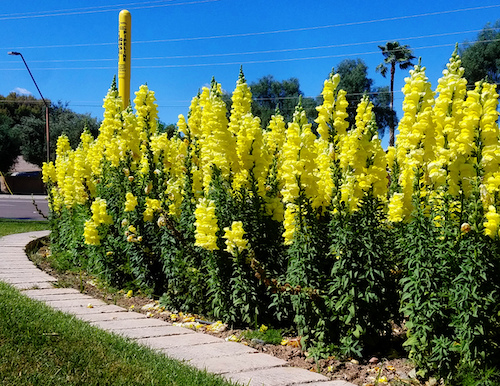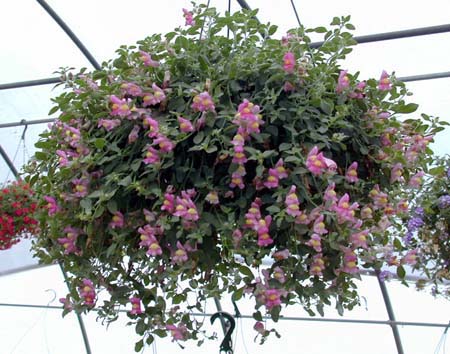Put Some Snap in Your Garden with Snapdragons
By Carolyn R. Casey, Fairfax Master Gardener
Snapdragons with their beautiful, tall, colorful and unique flowers make a great addition to your garden. Their Latin name is Antirrhinum majus. ‘Anti’ in Greek means ‘like’ and ‘rhinos’ means ‘snout’ and refers to the snapdragon flower’s resemblance to a dragon’s nose. The flower can be opened and closed in a snapping motion. As a child, I remember playing with the snapdragon flowers and opening the blossoms as if they had hinged jaws. Snapdragons are native to Mediterranean, Europe, Syria and Turkey.

Mid height snapdragon
They are one of my favorite plants. Snapdragon flowers come in every color except blue. I like planting them in my containers and in the garden. They like the cool weather when the temperatures are 60 to 70 degrees F (15 to 21 C) and grow best in the early spring or fall. Snapdragons have lots of healthy and luxuriant growth in cool weather. They like full sun to part shade, rich, moist well-drained soil with organic matter and a pH of 6.2 to 7.0. Snapdragons need watering with 1 inch of water per week once they are established.
Pinching off the stem tips will make your young plants thick, bushy and healthy. Deadheading your snapdragons will help to prolong their bloom time. They do not do well in hot and dry weather. They look spent in the late summer and need to be cut back to promote regrowth. In summer, snapdragons will slow down their growth and stop blooming. However, if you keep them watered they can become refreshed and last until the fall. They count on bumblebees for pollination because smaller bees cannot open the flowers’ “jaws.” Snapdragons bloom from the bottom of the stem upward.
Snapdragons are considered perennials but are classified with annuals. They cannot survive the winter and must be started indoors from seed or planted as seed directly into the ground every year. Planting seeds may be done a few weeks before the last frost. They can also be purchased as seedlings. Occasionally, snapdragons will reseed themselves for the next year.

Tall snapdragons
Snapdragons may be propagated from stem cuttings. Cut a 2-inch (5 cm) piece of stem below a leaf node on a plant. Remove the lower leaves and dip the bottom of the cutting into rooting hormone. Plant the cutting in a small pot with seed starter mix or potting soil. Cover the pot with a plastic bag to create a humid environment. Once the roots are developed, remove the bag and place the pot in a sunny window or under artificial light.
Snapdragon seeds can be started indoors by planting them in seed trays filled with moist seed starter soil mix. Set the seeds on top of the mix and press them to the surface but do not cover with soil. Water as needed with a mister creating a fine spray or put the tray into a container with a few inches of water for a half hour so the water is absorbed through the holes in the bottom of the tray. Then put the seed tray in a plastic bag to retain humidity and place it in an area with bright light. Check the soil frequently for moisture. The seeds will germinate in a week or two. After the seeds germinate take them out of the plastic bag so they do not rot or overheat. When they develop true leaves, transplant them into 3-inch (7 cm) pots or peat pots. Your snapdragon seedlings will need to be hardened off for 10 to 14 days before planting them outdoors. Since snapdragons can survive a light frost, they may be planted outside a couple weeks before your last frost date.
Snapdragons are classified on their flower form or height. There are three categories of height.
Dwarf plants grow 6 to 15 inches (15 to 38 cm) tall and are dense, bushy and produce an abundance of flower spikes. They work well as low border plants or in containers. Examples of the dwarf varieties of snapdragons are ‘Floral Carpet’ and ‘Floral Showers.’ Both of these grow 6 to 8 inches (15 to 20 cm) tall. These have the dragon jaw flowers. There is also a ‘Pixie’ mix that grows 7 to 9 inches (17 to 22 cm) tall and has a butterfly-looking flower. ‘Candy Tops’ grow 6 to 8 inches (15 to 20 cm) in solid colors of yellow, orange, white, red and rose. This mix may be used for edging and as bedding plants. ‘Tutti Frutti’ plants grow 10 to 12 inches (25 to 60 cm) tall and have rare speckled and striped flowers.
Mid-sized plants grow 15 to 30 inches (38 to 75 cm) tall and work well in borders and as cut flowers. Examples include the ‘Liberty’ series. These plants grow 18 to 22 inches (45 to 55 cm) tall and have dragon jaw flowers. The ‘Madame Butterfly’ mix grows 24 to 30 inches (60 to 75 cm) tall and has the double azalea flower form that is heavily ruffled. They come in all colors and are good to use for cut flowers. The ‘Princess’ series grows 16 to 18 inches (40 to 45 cm) tall and has the traditional dragon flower form.
Tall plants grow 30 to 48 inches (75 to 120 cm) tall and work well as plants in the back of your garden and also as cut flowers. The ‘Rocket’ series grows 30 to 36 inches (75 to 90 cm) tall with traditional flowers that are multi-colored and are great for cutting. Tall snapdragons may need to be staked up to keep them from falling over.

‘Chandelier’ snapdragons
The ‘Chandelier’ mix is a variety of trailing and draping snapdragons classified for their flower form with flowers that are lilac, pink and yellow. Their flowers are a little smaller than the other types.
Snapdragons may develop rust, mold, fungal leaf spots, downy mildew, wilt and root rot. Aphids and spider mites can also be a problem. If yellow flecks appear on your snapdragons that turn brown or black, then it has snapdragon rust. This occurs because your plants are planted too close together. You need to thin out your plants so that air can move around them. Do not water your snapdragons at night; this promotes the formation of mildew. Also, water snapdragons at their base and not overhead since this can also cause mildew.
Include snapdragons in your containers and gardens. With their tall spikes and beautiful eye- catching colors, they will make noticeable and standout additions to your gardens. Happy Gardening!
Resources
Now’s Time To Start Snapdragons From Seed, John Arbogast, Virginia Tech
Annuals: Culture and Maintenance, Diane Relf, Elizabeth Ball, Virginia Cooperative Extension
Snapdragons (snapdragons), Don Janssen, Nebraska Extension in Lancaster County
How to Grow and Care For Snapdragons, Marie Iannotti, the Spruce